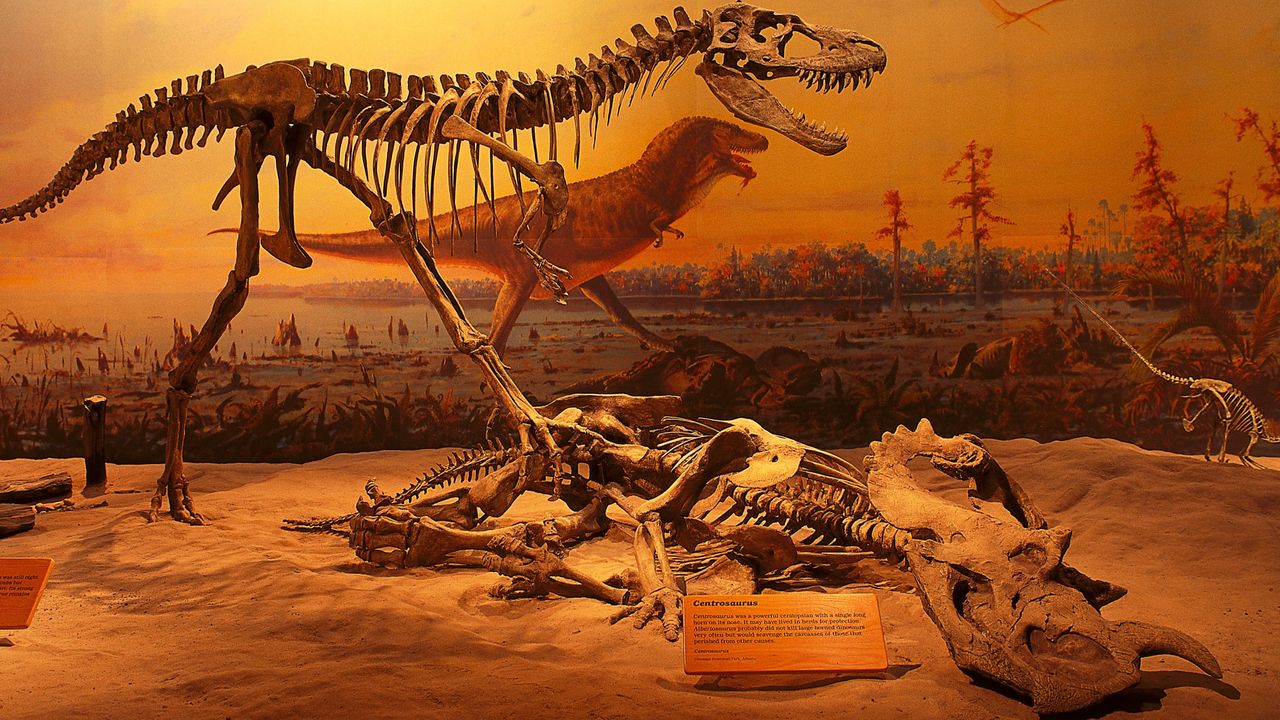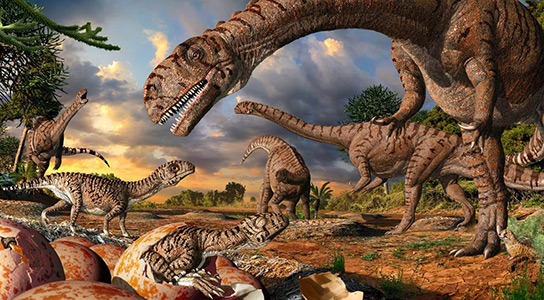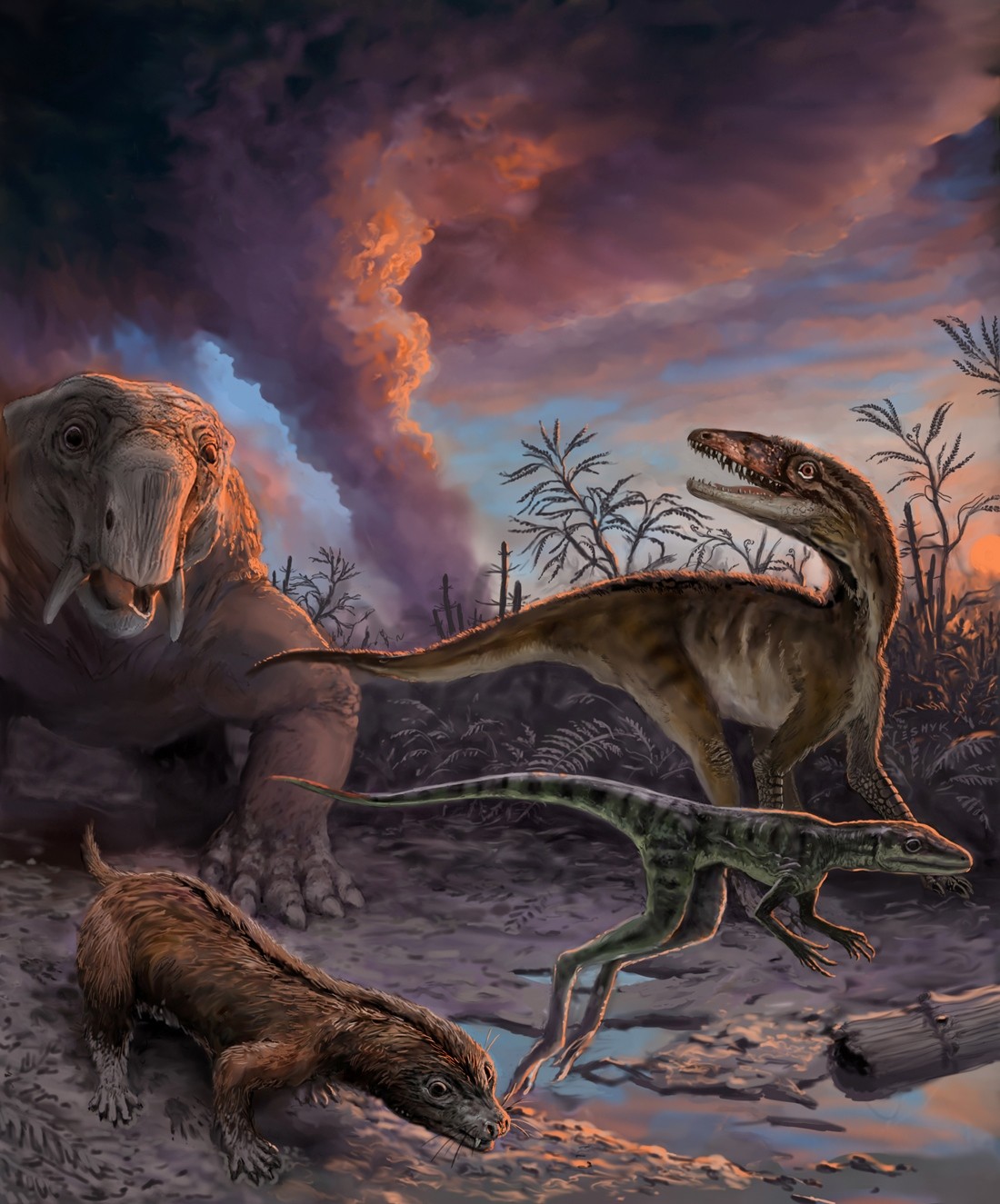A new study published in the Proceedings of the National Academy of Sciences sheds light on why early dinosaurs were small, rare and species-poor in tropical latitudes throughout the Late Triassic Period (235-201 million years ago), a pattern persisting 30 million years after their origin and 10-15 million years after they became abundant at higher latitudes.

Around 212 million years ago in what is now northern New Mexico, early dinosaurs such as the meat-eating dinosaur in background were small and rare, whereas other reptiles such as the long-snouted phytosaurs and armored aetosaurs were quite common. Image credit: Victor Leshyk.
For more than 30 million years after dinosaurs first appeared, they remained inexplicably rare near the equator, where only a few small-bodied carnivorous species present. The age-long absence of big plant-eaters at low latitudes is one of the great, unanswered questions in paleontology.

And now the mystery has a solution. The new findings suggest that the fluctuations, associated with high atmospheric carbon dioxide, may have prevented the establishment of a diverse community of large dinosaurs such as sauropods and their close relatives.
These dinosaurs likely require a productive and stable environment to thrive, conditions not present in equatorial North America until the beginning of the Jurassic Period, about 200 million years ago.
“Our data suggest it was not a fun place. It was a time of climate extremes that went back and forth unpredictably and large, warm-blooded dinosaurian herbivores weren’t able to exist nearer to the equator – there was not enough dependable plant food,” explained study co-author Dr Randall Irmis of the University of Utah and the Natural History Museum of Utah.

Dr Irmis and his colleagues examined rocks and fossils that come from Ghost Ranch in northern New Mexico, a site rich with fossils from the Late Triassic Period including the early carnivorous dinosaurs Coelophysis and Tawa hallae.
The rocks at Ghost Ranch were deposited by rivers and streams between 205-215 million years ago at a time when this area was much closer to the equator. During the Late Triassic northern New Mexico was at a latitude comparable to the southernmost tip of India today.
“By focusing so much effort at a single region like Ghost Ranch, we’ve made one of the largest and most detailed collections of Late Triassic fossil vertebrates in North America. Additionally, our team was able to provide the first detailed paleoenvironmental analysis for rocks that produce early dinosaur fossils,” said senior author Dr Alan Turner of Stony Brook University.

The paleontologists reconstructed the deep past by analyzing several kinds of data: fossils, charcoal left by ancient wildfires, and stable isotopes from organic matter and carbonate nodules that formed in ancient soils. Fossilized bones, pollen grains and fern spores revealed the types of animals and plants living at different times, marked by layers of sediment.
Dinosaurs remained rare among the fossils from Ghost Ranch, accounting for less than 15% of vertebrate animal remains. They were outnumbered in diversity, abundance and body size by the reptiles known as Pseudosuchian archosaurs, the lineage that gave rise to crocodiles and alligators.
The sparse dinosaurs consisted mostly of small, carnivorous theropods. Big, long-necked dinosaurs, or sauropodomorphs – already the dominant plant-eaters at higher latitudes – did not exist at the site or any other low-latitude site in Triassic Pangaea, as far as the fossil record shows.

The team found that wild climate swings during the Late Triassic Period correspond to changes in plant community structure, from a seed fern-dominated system to a conifer-dominated system, and that individual plant groups repeatedly alternated from rare to common through time.
“The conditions would have been something similar to the arid western United States today, although there would have been trees and smaller plants near streams and rivers and forests during humid times,” said study lead author Dr Jessica Whiteside of the University of Southampton, UK.
“The fluctuating and harsh climate with widespread wild fires meant that only small two-legged carnivorous dinosaurs, such as Coelophysis, could survive.”
Source: sci.news








